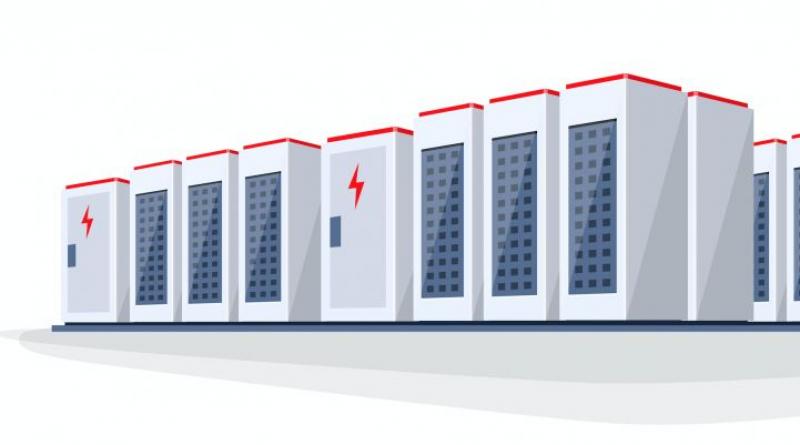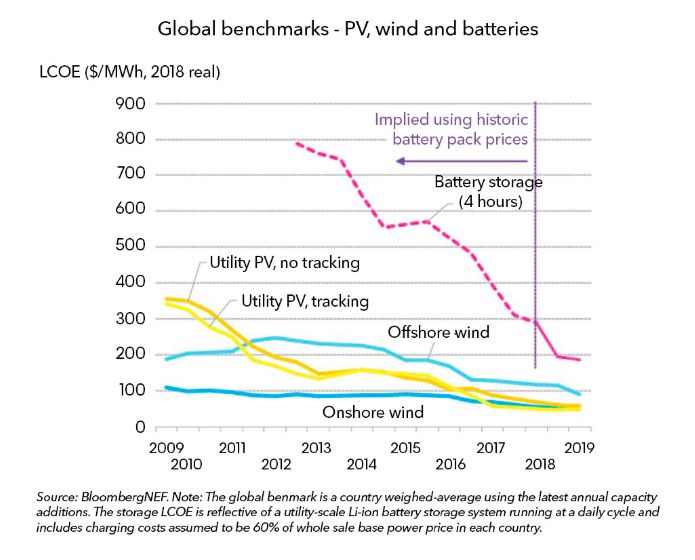Levelized Cost of Energy for Lithium-Ion Batteries Is Plummeting.

Bloomberg New Energy Finance finds the long-term costs of multi-hour energy storage can compete with natural gas and coal in an increasing number of markets today.
The long-term cost of supplying grid electricity from today’s lithium-ion batteries is falling even faster than expected, making them an increasingly cost-competitive alternative to natural-gas-fired power plants across a number of key energy markets.
That’s the key finding from a Tuesday report from Bloomberg New Energy Finance on the levelized cost of energy (LCOE) — the cost of a technology delivering energy over its lifespan — for a number of key clean energy technologies worldwide.
According to its analysis of public and proprietary data from more than 7,000 projects worldwide, this benchmark LCOE for lithium-ion batteries has fallen by 35 percent, to $187 per megawatt-hour, since the first half of 2018. This precipitous decline has outpaced the continuing slide in LCOE for solar PV and onshore and offshore wind power.
Over the past year, offshore wind saw a 24 percent decline in LCOE to fall below $100 per megawatt-hour, compared to about $220 per megawatt-hour only five years ago. The benchmark LCOE for onshore wind and solar PV fell by 10 percent and 18 percent, respectively, to reach $50 and $57 per megawatt-hour for projects starting construction in early 2019.
To be sure, these generation technologies are still far cheaper than batteries in terms of their LCOEs — and that’s not mentioning the fact that they actually make electricity, rather than simply storing it for later use. To convert a battery’s storage capacity into a LCOE figure, the report models a utility-scale battery installation running daily cycles, with charging costs assumed to be at 60 percent of the wholesale base power price for the country in question.
Even so, the pace of the decline in battery LCOE, particularly for multi-hour storage applications that previous generations of lithium-ion technologies have struggled to provide, is startling, BNEF notes. Since 2012, the benchmark LCOE of lithium-ion batteries configured to supply four hours of grid power — a standard requirement for many grid services — has fallen by 74 percent, as extrapolated from historical data.
In comparison, the LCOE per megawatt-hour for onshore wind, solar PV and offshore wind has fallen by 49 percent, 84 percent and 56 percent, respectively, since 2010.
In fact, the LCOE for multi-hour lithium-ion batteries is falling to the point that “batteries co-located with solar or wind projects are starting to compete, in many markets and without subsidy, with coal- and gas-fired generation for the provision of ‘dispatchable power’ that can be delivered whenever the grid needs it (as opposed to only when the wind is blowing, or the sun is shining),” the report notes.

These findings match those we’ve been covering from our own analysts at Wood Mackenzie Power & Renewables, as well as from the broader industry. In the past year and a half, several large-scale solar-battery requests for proposals have set record-low prices, including Xcel Energy in Colorado with solar-plus-storage bids as low as $36 per megawatt-hour, compared to $25 per megawatt-hour for standalone solar, and NV Energy reporting even lower bids in its solar and solar-plus-storage RFPs.
These price points equate to about a $6 to $7 per megawatt-hour premium for solar projects that are partially “dispatchable” in the manner of a traditional power plant, compared to standalone solar, Ravi Manghani, WoodMac energy storage research director, reported at Greentech Media’s Energy Storage Summit in December.
Just this week, clean energy advocacy and research organization Energy Innovation and Vibrant Clean Energy released a report finding that the LCOE of new renewables in the U.S. is lower than that of nearly three-quarters of the U.S. coal fleet — a not completely surprising finding, given the coal power industry’s well-documented challenges in competing with cheap natural gas, and increasingly cheap wind and solar power.
At the same time, it’s worth noting that the current trends in pricing for lithium-ion batteries, what they actually cost today, has been mixed. While continuing technology improvements and increasing scale of manufacturing have continued to push down prices, these have been somewhat counterbalanced in the past year or so by a bottleneck in available supply, driven by a boom in demand from big projects in the U.S. and South Korea.
WoodMac discovered that battery rack prices fell by only about 6 percent from 2017 to 2018, rather than the 14 percent range previously predicted, based on these supply shortage challenges.
26 March 2019





